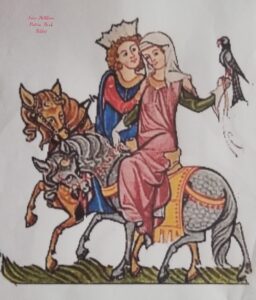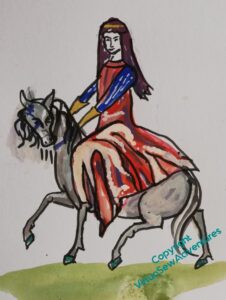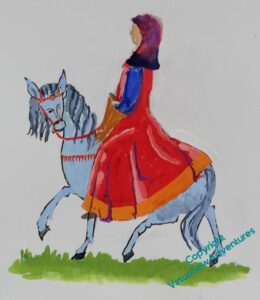Working on Aethelflaed
You may recall that the planning and designing of Aethelflaed is proving quite a long winded process, with a lot of repetition and rethinking going on.
I’ve been looking for medieval women on horseback, because I want Aethelflaed under her own steam, as it were – not lead on a palfrey, but mounted on her own horse, with the reins in her hands.
The best I’ve found so far is this one, which I think was in the Holkham Picture Book Bible.
I started with the lady, and began some alterations. I want her horse to have some personality, so I’ve turned the head towards us, and lifted it a little.
I’ve extended the skirts somewhat, and given the rider a veil that flies a little, held in place by a golden fillet.
But the high contrast suggests a silk or brocade, and I want something that suggests a sensible woollen riding dress.
Then I found some Viking and Anglo-Saxon reenactors and talked to them. And goodness, that gave me food for thought. In particular, yes, riding dress was indeed a garment that an Anglo Saxon woman like Aethelflaed might have worn. But Anglo-Saxon dressmaking was not at all like ours.
In particular, whereas we tend to have pattern pieces that start with the widest part, and remove fullness by means of darts, pleats, or gathers, Anglo-Saxon dressmaking started with the narrowest width and added fullness by means of gussets and gores. In fact, an Anglo Saxon riding dress would have a full circle’s worth of gores inserted into the side seams, resulting in something roughly like this.
But not quite. I’ve actually been to talk to my reenactor friends, and there are a few bits which don’t quite ring true. I have some photos to work from, so there is more to come…




I was once a passionate horsewoman and often wondered how women dressed for riding in earlier times. The big problem I found was that most of the information about this was written by men not women. They wrote what they expected women to wear. Now I know many women would have worn the kind of clothing they described but I am also sure many women, who were riders, would not have worn these clothes. This then brings up the question, do we perpetuate the written text or do we question it?
Being neither a horse rider nor an Anglo-Saxon, I can’t offer advice. It looks like an interesting field for research. I would imagine that a skirt could be wrapped between the legs to give almost a divided-skirt (and some probably-necessary padding for the sitting parts) while leaving the lower legs free for horse-control. A surcoat or cape could preserve the decencies, if necessary.
All those folksongs with a brave woman who “ties her kirtle green, a bit above the knee” make me think that practical dress wouldn’t be out of place.
I am always impressed with the amount of research you put into your work.
Good luck with finding what you are looking for.
What an interesting line of research – amazing where these things take us!
Certainly adding rather than subtracting fabric makes sense when you think about all the work that went into creating a piece of fabric in the first place. But absolutely fascinating!